|
|
|
Sort Order |
|
|
|
Items / Page
|
|
|
|
|
|
|
| Srl | Item |
| 1 |
ID:
130235
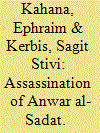

|
|
|
|
|
| Publication |
2014.
|
| Summary/Abstract |
Within the context of intelligence, the assassination of Egypt's President Muhammad Anwar al-Sadat on 6 October 1981 can be characterized as both a symbolic security failure and a failure to implement professional security principles by those responsible for guarding his life.
The circumstances creating the security "hole" were not confined to the short period preceding the assassination, but rather began long before, as part of an intense clash between two conflicting forces: extreme Islam and modern statehood.
In contrast to prevailing opinion, the apex of the struggle between these two forces is the main reason for the assassination, and not Sadat's peace with Israel. 1 The assassins of the al-Jihad group, springing unchecked from the substratum of fundamentalist Islam, carried out their work resolutely, exploiting the circumstances with almost incredible ease.
The sixth of October, observed in Egypt as a day of military triumph over the Israel Defense Forces (IDF) in the October 1973 War (the Yom Kippur War), is celebrated as an official holiday at the Grave of the Unknown Soldier on the outskirts of Cairo. On that date in 1981, on the reviewing stand stood President Sadat and his entourage: Vice President Hosni Mubarak; Defense Minister Mohammad Abu-Gazala; members of parliament; and members of the diplomatic corps, among them Israeli Ambassador Moshe Sassón.
Mirage fighter planes flew in celebratory formation above, and all in attendance were occupied with watching them and the huge parade passing before the reviewing stand, as columns of soldiers marched past the proud president.
When it was the artillery unit's turn to pass, a military truck stopped suddenly, from which four uniformed men sprang. Thinking this was part of the pageantry, no security personnel acted to prevent them from approaching the reviewing stand. One of the men quickly threw a grenade that did not explode, followed by more grenades. The assassins cocked their weapons and charged, firing at those on the reviewing stand.
The speed and suddenness with which the assassination was carried out resulted in pandemonium. People ran in all directions to take cover while Sadat stood, stiff and in shock, making him a clear target for sniper Hussein Abbas, 2 who shot him in the neck and chest. Sadat collapsed on the spot, yet this did not prevent another assassin, Abed al-Hamid, from emptying the rest of his rifle's magazine unhindered to confirm the kill. Sadat was flown by Gazelle helicopter to the Armed Forces Military Hospital at Ma'adi, but he arrived with no pulse, as his chest and arteries had been fatally penetrated.
The individual responsible for the assassination was Captain Khalid al-Islambouli. The fact that he and his partners managed to carry out this "inside job," despite explicit warnings having been received of threats on the president's life at the parade, testifies to a complete absence of common sense on the part of the Egyptian security sector.
The head of the Israeli security unit and lead investigator of the assassination, who was also responsible for Ambassador Sasson's rescue, was Avraham Rotem. According to Rotem, some members of Sadat's security detail were known to Rotem's unit personally due to previous reciprocal visits between Israeli and Egyptian personnel. 3 For this reason, the part played by Egyptian security personnel that day remains a mystery, due precisely to Israel's familiarity with them and the fact that they had acquired their security expertise from the best American instructional training. Sadat's assassination therefore raises a number of burning questions emanating from the fact that many in the upper Egyptian echelons knew that Sadat was in the opposition's crosshairs.
|
|
|
|
|
|
|
|
|
|
|
|
|
|
|
|
| 2 |
ID:
114206
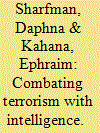

|
|
|
| 3 |
ID:
177926
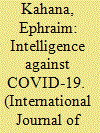

|
|
|
| 4 |
ID:
158534
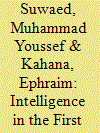

|
|
|
|
|
| Summary/Abstract |
Intelligence skills and security awareness were consistent with the rise and spread of Islam as a new religion.1 According to Muslim tradition, Muhammad habitually sought solitude on Mount Hiraa, near Mecca. One night in the year 610 AD, he had an epiphany: the angel Gabriel appeared in a dream and ordered him to read, but Muhammad refused. Some claim that he was afraid of the magnitude of the mission, while others claim that he was simply illiterate. But when the angel insisted, he read certain verses from the Qur’an. When he awoke he returned home, telling his wife Hadija about the epiphany. Hadija was to first to realize that it was a revelation, and that Muhammad was the emissary of the Lord. Becoming the first believer, Hadija thereafter supported Muhammad every step of the way. Without her it would have been extremely difficult for him to accept the burden of the revelation and the divine mission. See: The Holy Qur’an, Chapter 53—An-Najm (The Star), Verse 4; The Holy Qur’an, Chapter 96—Al-‘Alaq ((The Clot), Verses 1–5;
Emory C. Bogle, Islam: Origin and Belief (Austin: University of Texas Press, 1998), p. 6.
[Google Scholar][Google Scholar]
In its first three years of inception, Islam was an underground movement. The prophet Muhammad (570–632 AD) realized that, due to the hostility of the dominant majority in Mecca, he had to be cautious of his moves and intentions and those of his followers. What was becoming a new religion was revealed to only his most carefully selected and loyal associates. The Prophet knew that, in the preliminary stage, any information spillage could lead to harsh responses from the local civil and spiritual leaders, including measures to suppress this new religious movement. Thus, he adopted secrecy, regarding not only the identity of his selected recruits/believers but also the location of their meeting place—the house of Islam—a secret safe house where he met and preached to those he invited to join the new religion.
|
|
|
|
|
|
|
|
|
|
|
|
|
|
|
|
| 5 |
ID:
127937
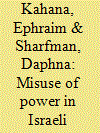

|
|
|
|
|
| Publication |
2014.
|
| Summary/Abstract |
One of the relatively minor security organizations in the Israeli Ministry of Defence, the MALMAB - tasked with protecting Israel's well-known policy of nuclear ambiguity - has gone beyond the usual criminal process established by the rule of law to the grey area of interrogating and even harassing people who seemed to not abide by its strict policies, thus highlighting the tension between legal rules and non-legal sanctions exercised in the name of national security. This article analyses three different cases connected to the issue of nuclear ambiguity, while aiming to debate the sensitive issue, prominent in every democracy, of the limits and balance of security versus democracy.
|
|
|
|
|
|
|
|
|
|
|
|
|
|
|
|
|
|
|
|
|